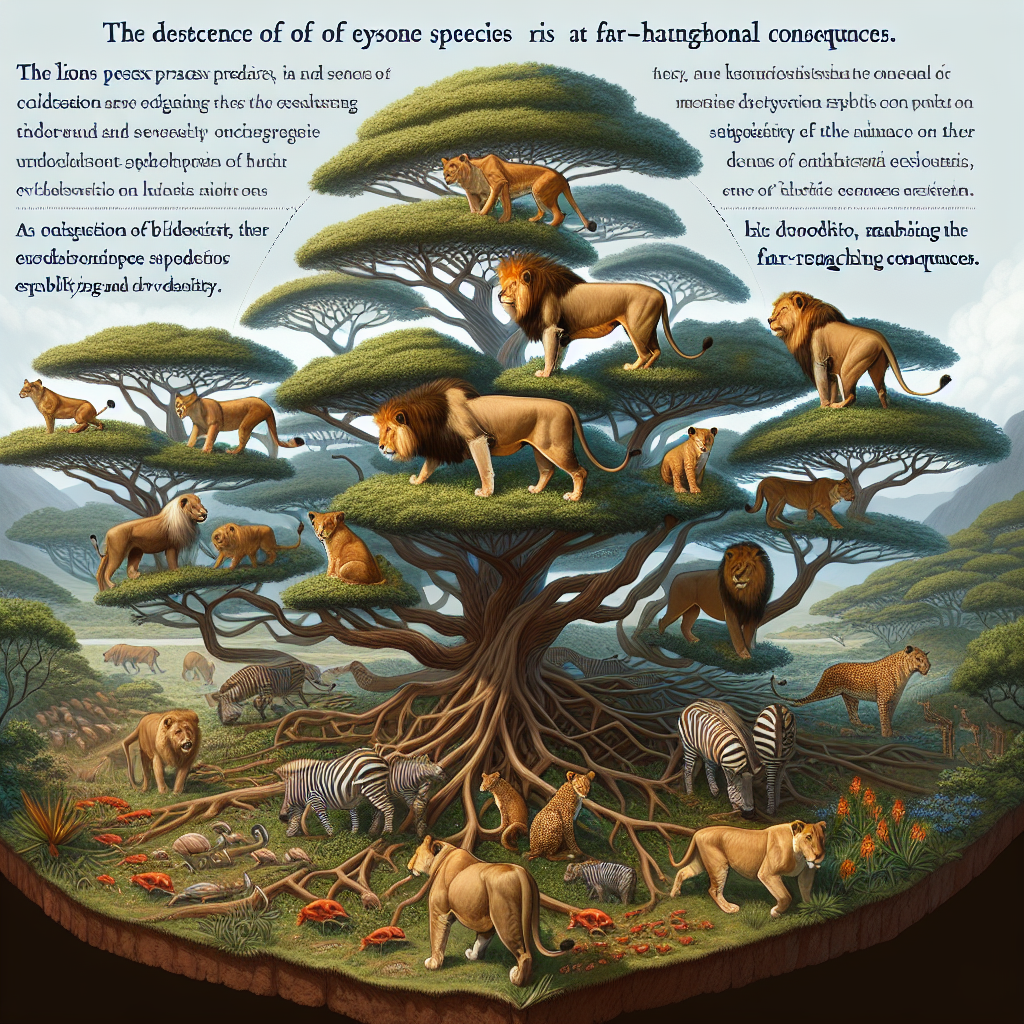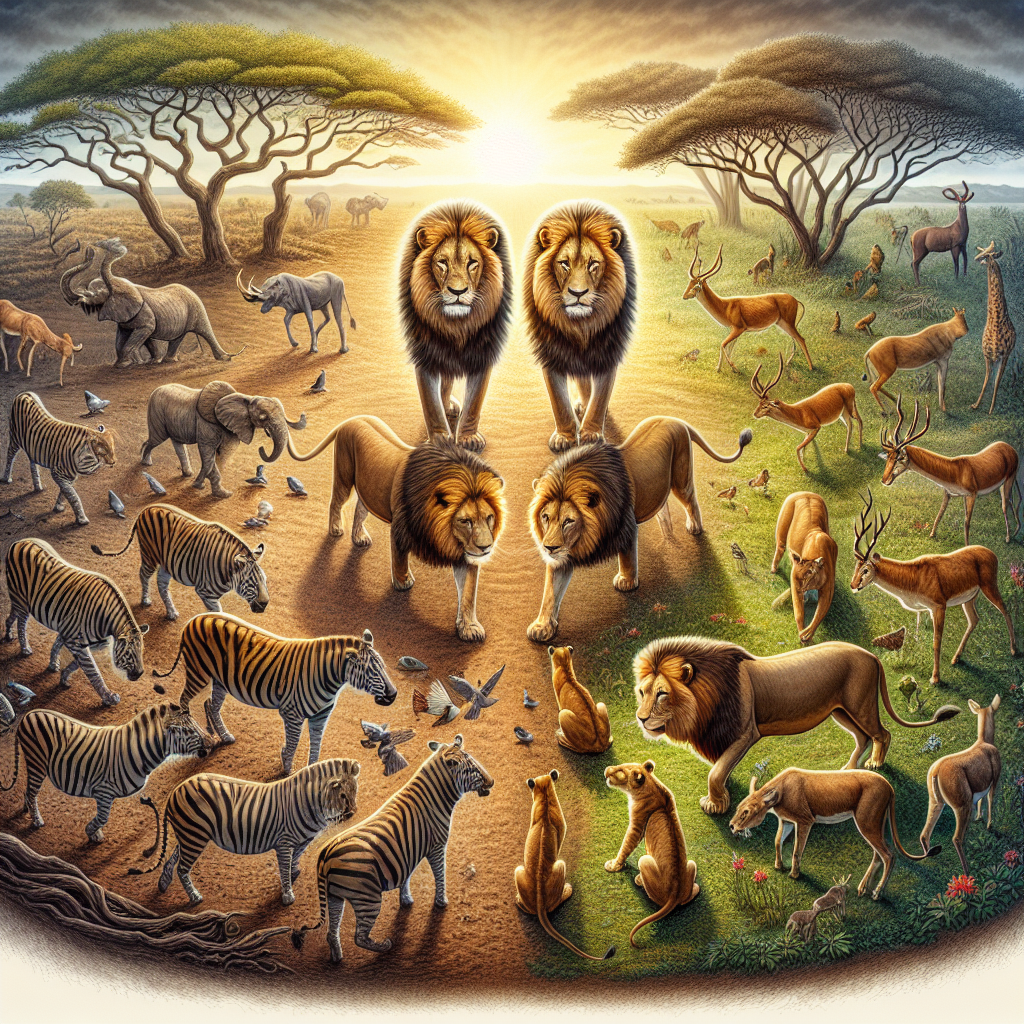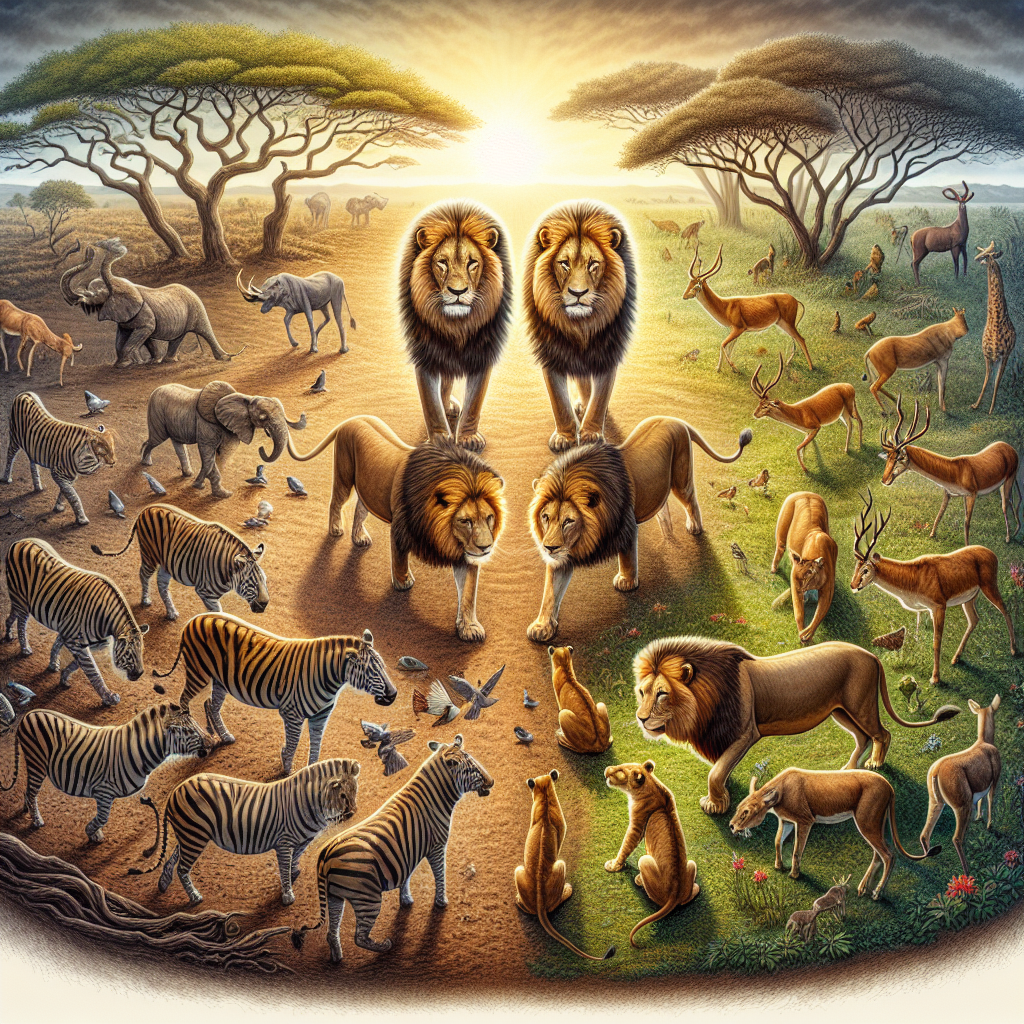Lions may be known as the kings of the jungle, but their significance in ecosystems extends far beyond their royal stature. From regulating prey populations to shaping vegetation patterns, these majestic predators play a vital role in maintaining the delicate balance of the natural world. However, understanding the full extent of their impact requires delving into the expertise of those who have dedicated their lives to studying these magnificent creatures. In this article, we will explore the invaluable insights provided by experts in the field, shedding light on the multifaceted role of lions in ecosystems and emphasizing the importance of their conservation.
The Importance of Lions in Ecosystems
Lions as Keystone Species
Lions are known as keystone species, meaning they play a crucial role in maintaining the balance and stability of their ecosystems. As top predators, lions help regulate prey populations, which in turn has a significant impact on the entire food chain. By exerting control over prey species, lions prevent overgrazing and ensure healthier ecosystems.
Impacts on Prey Populations
Lions have a direct influence on the population dynamics of their prey species. Their hunting activities help control the number of herbivores, such as zebras and wildebeests, which prevents overpopulation and helps maintain a healthy balance in ecosystems. By thinning out the herds, lions target weaker individuals, thus ensuring that the fittest survive and breed, further strengthening the genetic pool of the prey population.
Indirect Effects on Ecosystem Balance
Aside from directly influencing prey populations, lions also have indirect effects on the balance of ecosystems. Through predation, they shape the behavior of their prey, creating a more alert and adaptive prey population. This increased vigilance can have cascading effects on other organisms and contribute to a healthier ecosystem overall.
Lions and Biodiversity Conservation
Preserving Natural Ecosystems
Conservation efforts for lions not only safeguard the species itself but also act as a means to preserve entire natural ecosystems. By protecting lion habitat, we ensure the preservation of diverse flora and fauna that rely on these habitats for survival. This, in turn, helps maintain ecological balance and protects the biodiversity within the ecosystem.
Maintaining Species Diversity
Lions also contribute to the maintenance of species diversity within their ecosystems. Their presence helps maintain a complex web of interactions between different organisms, supporting the survival of a wide range of species. Without this keystone species, the delicate balance of the ecosystem can be disrupted, leading to a loss of biodiversity.
Conservation Challenges
Conservation efforts for lions face numerous challenges. Habitat loss and fragmentation, as a result of human activities such as agriculture and infrastructure development, pose a significant threat to lion populations. Additionally, human-wildlife conflict and poaching are persistent issues that require ongoing attention and action. Protecting lions and their ecosystems necessitates a multi-faceted approach, involving local communities, governments, and conservation organizations.

Lions and Trophic Cascades
Understanding Trophic Cascades
Trophic cascades refer to the impacts of changes in predator populations on lower trophic levels, which can have far-reaching effects throughout an ecosystem. When predators like lions are removed or their populations decline, it disrupts the delicate balance within the food chain and can result in a trophic cascade.
Lions as Top Predators
As top predators, lions have a significant impact on their ecosystems. By regulating herbivore populations, they prevent overgrazing and the subsequent degradation of vegetation. This, in turn, helps maintain the integrity of the ecosystem, supporting a more diverse range of species.
Trophic Cascade Effects
The presence or absence of lions can trigger trophic cascade effects. For example, in areas where lion populations have declined or been extirpated, such as parts of Africa, herbivore populations may increase unchecked. This overgrazing can lead to habitat degradation, decreased food availability for other species, and alterations in the overall structure and function of the ecosystem.
Lions and Grazing Patterns
Predator-Prey Dynamics
Lions’ influence extends beyond direct predation. The mere presence of lions can shape the behavior of their prey, particularly herbivores. The fear of predation alters the grazing patterns of herbivores, as they avoid areas where lions are known to be present. These changes in grazing patterns can have important consequences for vegetation dynamics and nutrient cycling in the ecosystem.
Influence on Herbivore Behavior
The fear of predation by lions leads herbivores to graze in a more nomadic and dynamic manner. This prevents overgrazing in specific areas and allows vegetation to recover, promoting healthier grazing patterns across the ecosystem. The alteration of herbivore behavior induced by lions ultimately benefits the entire ecosystem and helps maintain a sustainable balance.
Promoting Healthy Grazing Patterns
The presence of lions helps promote healthy grazing patterns and prevent overutilization of specific areas. By keeping herbivores on the move, lions ensure a more even distribution of grazing pressure. This allows vegetation to recover in certain areas while maintaining a mosaic of grazing intensities, which ultimately benefits the ecosystem as a whole.

The Impact of Lion Conservation Efforts
Protecting Lion Populations
Conserving lion populations is crucial for maintaining the delicate balance of ecosystems. Efforts such as habitat protection, anti-poaching measures, and community-based conservation initiatives help safeguard these iconic predators. By ensuring the long-term survival of lions, we contribute to the preservation of their ecosystems and the biodiversity they support.
Mitigating Human-Wildlife Conflict
Human-wildlife conflict is a significant challenge in lion conservation. As lion habitats overlap with human settlements, conflicts arise when lions come into conflict with livestock and pose a threat to human lives. Developing strategies to mitigate these conflicts, such as lion-proof enclosures for livestock or providing alternative livelihoods for communities living near lion habitats, is vital for promoting coexistence and ensuring the survival of lions.
Ecotourism and Economic Benefits
The conservation of lions can also bring economic benefits to local communities through ecotourism. Lions are charismatic and iconic species, attracting tourists from around the world. This tourism generates revenue for communities, which can be reinvested in conservation efforts and community development. By highlighting the economic value of lions, conservation efforts can gain support and provide sustainable livelihoods for local populations.
Lions in African Ecosystems
Savannah Ecosystems
Lions are an integral part of African savannah ecosystems. They are well adapted to the open grasslands, where they can utilize their stealth and hunting prowess to prey on ungulates such as zebras and wildebeests. The presence of lions in these ecosystems helps maintain the balanced interactions between predators, herbivores, and plants, contributing to the overall health and functioning of the savannah.
Role in Grassland Ecosystems
In grassland ecosystems, lions act as top predators that regulate herbivore populations and control the balance between prey and vegetation. Through their hunting activities, lions prevent overgrazing and maintain the integrity of grassland habitats. The presence of lions ultimately contributes to the overall health and sustainability of these ecosystems.
Lions in Forested Areas
Although lions are commonly associated with savannah ecosystems, they also inhabit forested areas in certain regions. Forested habitats provide unique challenges and opportunities for lions, as they adapt their hunting strategies to navigate the complex vegetation and prey resources available in these environments. The presence of lions in forested areas can help regulate prey populations and maintain the natural dynamics of these ecosystems.
Lions and Prey Interactions
Predation Patterns
Lions employ various predation strategies to successfully hunt their prey. They often target vulnerable individuals, such as young or sick animals, as they are easier to catch. Lions also rely on teamwork and cooperative hunting behaviors to bring down larger prey, utilizing their strength in numbers to increase their chances of success. These predation patterns play a crucial role in shaping prey populations and maintaining ecosystem balance.
Prey Selection
Lions are opportunistic hunters and display a wide range of prey preferences. While they are commonly associated with large ungulates like zebras and wildebeests, lions will also prey on smaller mammals, birds, and even reptiles. Their adaptability in prey selection allows them to respond to changes in prey availability, ensuring that the ecosystem remains in balance.
Influence on Prey Behavior
The presence of lions has a profound influence on prey behavior. Prey species develop mechanisms to avoid predation, such as increased vigilance, herding behavior, and altered movement patterns. These behavioral changes, induced by the fear of predation, have cascading effects on prey populations and their interactions with other species, ultimately shaping the dynamics of the entire ecosystem.
Lions and Competition with Other Predators
Interactions with Hyenas
Lions and hyenas often compete for similar prey resources and face a complex relationship in many ecosystems. Both species are skilled hunters and opportunistic scavengers. While hyenas are capable of stealing kills from lions, lions’ intimidation techniques can often force hyenas to abandon their attempts. The balance between lions and hyenas in an ecosystem can influence prey dynamics and overall ecosystem health.
Conflict with African Wild Dogs
African wild dogs, also known as painted dogs, compete with lions for prey and face similar conservation challenges. Both species require large home ranges to find adequate resources, and their overlapping territories can lead to conflicts. African wild dogs typically avoid direct confrontations with lions, but competition for prey can result in reduced food availability and potential population declines for either species.
Competing with Leopards
Leopards also share habitat with lions in many African ecosystems and can compete for similar prey. While leopards are skilled climbers and can successfully hunt arboreal species, their ground-based hunting can bring them into direct competition with lions. The coexistence of these large predators is influenced by factors such as prey availability, habitat structure, and individual territorial behavior.
Lions and Human-Wildlife Conflict
Lion Attacks on Livestock
Human-wildlife conflict arises when lions come into conflict with human interests, particularly livestock. This conflict can result in retaliatory killings, as communities may perceive lions as a threat to their livelihoods. Addressing this issue requires strategies such as introducing predator-proof enclosures for livestock, improving husbandry practices, and compensating affected communities.
Human Encroachment on Lion Habitat
The expansion of human settlements and agricultural activities often encroach upon lion habitats, leading to increased contact and conflict. Encouraging sustainable land-use practices, supporting community-based conservation initiatives, and establishing protected areas are crucial for minimizing human encroachment and maintaining suitable habitats for lions and other wildlife.
Conflict Resolution Strategies
Conflict resolution strategies aim to find sustainable solutions that address the needs of both humans and lions. These strategies can include community education programs, the establishment of wildlife corridors to minimize human-wildlife interactions, and the development of compensation mechanisms for communities affected by predation or livestock losses. Balancing the interests of both humans and lions is essential for ensuring the survival of these magnificent creatures and the harmony of ecosystems.
The Future of Lions in Ecosystems
Conservation Strategies
To secure the future of lions and their ecosystems, comprehensive conservation strategies are essential. These strategies should include the protection of lion habitats, anti-poaching measures, community involvement, and vigilant monitoring of lion populations. By implementing and supporting these strategies, we can ensure the long-term survival of lions and the ecosystems they depend on.
Climate Change Impacts
Climate change poses additional challenges for lion conservation and ecosystem stability. Changes in temperature, precipitation patterns, and habitat availability can impact both lion prey species and the vegetation they rely on. Understanding and addressing these climate-related impacts is crucial for adapting conservation efforts and ensuring that lions and their ecosystems have the resilience to withstand future changes.
Long-Term Survival Challenges
The long-term survival of lions and their ecosystems relies on ongoing commitment and collaboration. As human populations continue to grow, the pressure on land and natural resources increases, further threatening lion habitats. It is imperative that governments, conservation organizations, and local communities work together to protect lions, mitigate human-wildlife conflict, and promote sustainable practices that allow lions to thrive within their ecosystems for generations to come.
In conclusion, lions play a vital role in maintaining the balance and functioning of ecosystems. As keystone species, their influence extends beyond predation, shaping prey populations, promoting healthy grazing patterns, and maintaining biodiversity. Conservation efforts and addressing human-wildlife conflict are crucial for securing the future of lions and their ecosystems. By understanding their ecological importance and taking action, we can ensure the long-term survival of these magnificent creatures while preserving the integrity and beauty of their habitats.

